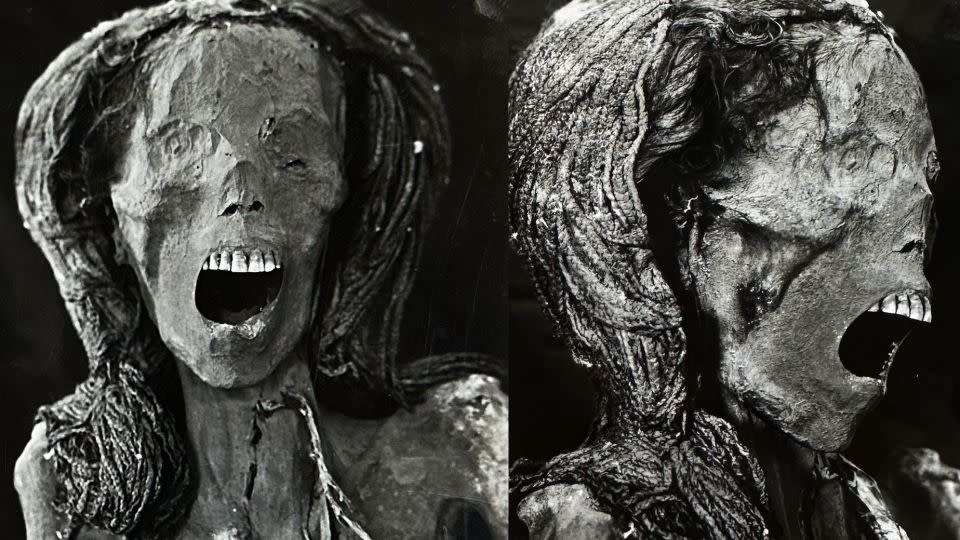Editor’s note: A version of this story appeared in CNN’s Wonder Theory newsletter. To receive it in your inbox, Sign up for free here.
The pyramids, pharaohs and artifacts of Ancient Egypt delight the imagination, rekindling the wonder of the distant past in each generation.
Today, archaeologists still make captivating discoveries in the Nile Valley. An expedition in Damietta, Egypt, recently unearthed 63 tombs dating back more than 2,500 years, alongside a treasure of coins, gold objects and ceramics.
Experts are also using the latest techniques to reveal secrets hidden in discoveries made decades ago, with new research this week “digitally dissecting” an unusual mummy found in 1935.
A long time ago

With her mouth open, the mummified woman appears to be trapped for eternity in an agonizing scream – a feature noted by archaeologists who originally found her remains in a tomb near Luxor during an expedition nearly a century ago led by the Metropolitan Museum of Art. in New York City.
What could have caused this disturbing facial expression?
Aiming to solve the mystery, Sahar Saleem, professor of radiology at Cairo University’s Kasr Al Ainy Hospital, used computed tomography scans to reveal details about the woman’s morphology, health conditions and preservation. Infrared imaging and other advanced techniques also helped shed light on her life.
The woman was 48 years old when she died and, interestingly, her organs were still in her body, contrary to typical funeral rites, Saleem discovered. Although Saleem was unable to determine the exact cause of death, the the information she gathered led to a terrifying hypothesis.
Other worlds
Scientists believe the solar system’s smallest planet could be hiding a layer of diamonds up to 18 kilometers (11 miles) thick. It may have formed shortly after Mercury merged into a planet about 4.5 billion years ago, according to a recent study.
To understand how diamonds could have been created, researchers conducted an experiment using a huge machine called an anvil press and a synthetic mixture of elements that mimicked the theorized composition of Mercury’s early interior.
The study team found that one of the ingredients, graphite, a form of carbon, transformed into diamond crystals under these conditions. Without samples from the planet’s surface, it is not possible to know for sure whether the same process took place there.
However, a mission led by the European Space Agency and the Japan Aerospace Exploration Agency called BepiColombo, which is expected to begin orbiting Mercury next year, may tell scientists more.
Discoveries


Venus, sometimes called Earth’s evil twin for its surface temperatures that can melt lead and clouds made of corrosive sulfuric acid, is perhaps the most hostile place for life in the solar system.
However, scientists have detected two gases, phosphine and ammonia, that on Earth would be considered biomarkers of life.
Four years ago, when phosphine was unexpectedly discovered in Venusian clouds, the discovery sparked controversy. Now scientists say that have stronger evidence that phosphine is present and detected ammonia.
The results are only preliminary and require independent confirmation, but they make upcoming missions and flybys of Venus, such as the Jupiter Icy Moons Explorer and DAVINCI, particularly important and exciting.
We are family
Homo sapiens, our species, shared the planet with Neanderthals, the archaic humans who lived in Europe and much of Asia for at least 250,000 years.
An enduring mystery is why Neanderthals became extinct while early modern humans came to dominate and inhabit every corner of the Earth.
A new analysis of ancient DNA suggests there was multiple waves of crossover between the two groupsand these population dynamics may have meant that the Neanderthal population became smaller and less diverse over time as its gene pool was absorbed into the modern human population.
Some of the genes inherited from our Neanderthal ancestors still impact lives today.
Once upon a time there was a planet


“Every rose has its thorn,” sang glam metal band Poison in their famous 1980s power ballad. But a new discovery by geneticists could open the door to thornless roses.
Protruding from the stems to ward off animals in search of a snack, the spiky features are a defense mechanism, shared by many plants such as tomatoes, eggplant, barley and rice sprouts, which have evolved over 400 million years.
A new study has identified an ancient family of genes responsible for the characteristic, known as Lonely Guy, or LOG, which could be the target of gene editing techniques. Removing thorns can make harvesting easier and bring lesser-known products to supermarkets.
Explorations
Dive deep into these fascinating discoveries.
— An insect-like sea creature that lived half a billion years ago looked a little like a taco and had a fundamental characteristic that many animals share today and another that still confuses researchers.
— Scientists have detected unexpected X- and C-shaped structures in the atmosphere, and they are struggling to explain them.
— To keep swimmers and beachgoers safe, scientists are using artificial intelligence to detect juvenile sharkswho like to stay close to the coast.
— A forest complex in Thailand offers new hope for Endangered tigers in Southeast Asia.
Did you like what you read? Oh, but there’s more. Sign here to get the next issue of Wonder Theory delivered to your inbox, brought to you by CNN Space and Science writers Ashley Strickland It is Katie Hunt. They find wonders on planets beyond our solar system and in discoveries from the ancient world.
For more news and newsletters from CNN, create an account at CNN.com






























